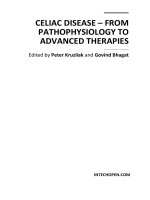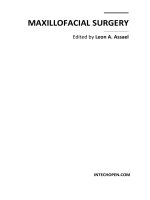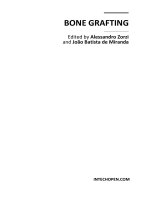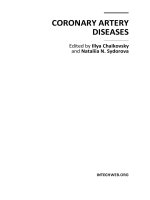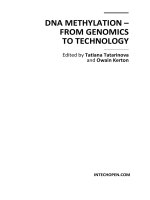Orthopedic Surgery Edited by Zaid Al-Aubaidi and Andreas Fette doc
Bạn đang xem bản rút gọn của tài liệu. Xem và tải ngay bản đầy đủ của tài liệu tại đây (23.57 MB, 232 trang )
ORTHOPEDIC SURGERY
Edited by Zaid Al-Aubaidi and Andreas Fette
Orthopedic Surgery
Edited by Zaid Al-Aubaidi and Andreas Fette
Published by InTech
Janeza Trdine 9, 51000 Rijeka, Croatia
Copyright © 2012 InTech
All chapters are Open Access distributed under the Creative Commons Attribution 3.0
license, which allows users to download, copy and build upon published articles even for
commercial purposes, as long as the author and publisher are properly credited, which
ensures maximum dissemination and a wider impact of our publications. After this work
has been published by InTech, authors have the right to republish it, in whole or part, in
any publication of which they are the author, and to make other personal use of the
work. Any republication, referencing or personal use of the work must explicitly identify
the original source.
As for readers, this license allows users to download, copy and build upon published
chapters even for commercial purposes, as long as the author and publisher are properly
credited, which ensures maximum dissemination and a wider impact of our publications.
Notice
Statements and opinions expressed in the chapters are these of the individual contributors
and not necessarily those of the editors or publisher. No responsibility is accepted for the
accuracy of information contained in the published chapters. The publisher assumes no
responsibility for any damage or injury to persons or property arising out of the use of any
materials, instructions, methods or ideas contained in the book.
Publishing Process Manager Vedran Greblo
Technical Editor Teodora Smiljanic
Cover Designer InTech Design Team
First published March, 2012
Printed in Croatia
A free online edition of this book is available at www.intechopen.com
Additional hard copies can be obtained from
Orthopedic Surgery, Edited by Zaid Al-Aubaidi and Andreas Fette
p. cm.
ISBN 978-953-51-0231-1
Contents
Preface IX
Part 1 Spine 1
Chapter 1 Microsurgical Management and Functional
Restoration of Patients with Obsolete Spinal Cord Injury 3
Zhang Shaocheng
Chapter 2 Unilateral Minimally Invasive Posterior Lumbar
Interbody Fusion (Unilateral Micro-PLIF) for
Degenerative Spondylolisthesis: Surgical Technique 27
Shigeru Kobayashi
Part 2 Upper Extremity 43
Chapter 3 The Distal Forearm Region –
Ultrasonographic Anatomy in Children and Adolescents 45
Johannes M. Mayr, Wolfgang Grechenig, Ursula Seebacher,
Andreas Fette, Andreas H. Weiglein and Sergio Sesia
Chapter 4 Limited Hand Surgery in Epidermolysis Bullosa 61
Bartlomiej Noszczyk and Joanna Jutkiewicz-Sypniewska
Chapter 5 Special Aspects of Forearm
Compartment Syndrome in Children 79
Andreas Martin Fette
Part 3 Hip 99
Chapter 6 The Genotoxic Potential of Novel Materials
Used in Modern Hip Replacements for Young Patients 101
Aikaterini Tsaousi
Chapter 7 Total Hip Arthroplasty After Previous
Acetabulum Fracture Surgery 127
Babak Siavashi
VI Contents
Part 4 Basic Science 139
Chapter 8 Bisphosphonates and Bone 141
Sirmahan Cakarer, Firat Selvi and Cengizhan Keskin
Chapter 9 Biochemical Measurement of Injury
and Inflammation in Musculoskeletal Surgeries 165
Dinesh Kumbhare, William Parkinson, R. Brett Dunlop
and Anthony Adili
Part 5 Anesthesia Considerations for
Orthopaedic Trauma Surgery 183
Chapter 10 Anesthesia for Orthopedic Trauma 185
Jessica A. Lovich-Sapola and Charles E. Smith
Preface
Looking into the fascinating field of orthopedic surgery, pediatric hand surgery is
surely one of our most challenging subspecialties. It is often difficult to quickly find
the correct diagnosis and treatment in pediatrics, and surely the surgical anatomy of
the growing hand is amazingly complex. In addition, some diagnoses are rare and less
often mentioned in common surgical textbooks.
I graduated from Baghdad University, school of medicine in 1993. At that time, the
standard texts in basic and clinical medical science were available only in the form of
hard copies, books. I can remember that these books were heavy, expensive, and not
least hard to get. The access to journals was only available in hard copy forms.
Registration and being a member was a prerequisite for that. Being a medical student
with almost no income made this almost impossible.
Since that time, I thought; this was wrong! I believed, and still do, that knowledge and
science although invaluable, should be accessible for everyone. As we are dealing with
medical science, the accessibility is even more important. This would mean a better
knowledge for doctors and hence better treatment for patients. Through the last years,
I had the chance to work in Africa for short periods. I have seen the willingness of the
local doctors to give the right and best treatment for their patients. Beside the
deficiency of postgraduate education and guidance, missing text books and essential
medical journals are obstacles that make it very difficult for these doctors to
accomplish their goal.
To share our inspiration we would like to present the following chapters;
Obsolete or chronic traumatic paraplegia is still a difficult medical problem at present
time. So what factors then affect the recovery of the nerves functions? Through 17
anatomical studies and operative observations, and can nerve transplantation help in
regaining some function? Chapter 1 will be able to answer these questions.
Degenerative spondylolisthesis has long been recognized as a cause of chronic low
back pain. The mechanism of pain in degenerative spondylolisthesis has been
confirmed by demonstrating the disc lesion pre-operatively by X-rays and MR
imaging usually treated with surgical interbody fusion. With advances in minimal
X Preface
access technology using operating microscope, PLIF can now be performed through a
minimally invasive. In chapter 2 the authors present a novel surgical technique and
clinical outcomes of the unilateral micro-PLIF for degenerative spondylolisthesis. The
distal forearm and surrounding soft tissues are commonly affected by acute and
chronic disorders. In children, the use of ultrasonography allows the chondral parts of
the epiphyseal region to be better evaluated without exposure to radiation than using
standard radiographic techniques. The aim of this study in chapter 3 is to demonstrate
the normal ultrasonographic findings in the distal forearm region in children.
Epidermolysis bullosa, form an entity of rare congenital diseases with an
extraordinary susceptibility of the epithelium and skin to even minimal injury. This
epidermal tears lead to blister formation and finally into serious wounds, leaving
behind disabling scars and contractions, sometimes even leading to early death. The
authors offer the reader of chapter 4 an exciting overview into the treatment of this
disease
Compartment Syndrome, is a serious condition of various etiology and clinical
presentation. The diagnosis of Compartment Syndrome of the forearm usually needs
emergency surgery to prevent disabling sequelae. A comprehensive overview about
this pediatric hand surgical challenge will be given by Andreas Fette in chapter 5.
Total hip replacement is the most common practiced and most effective surgical
interventions introduced in the last 50 or so years in medicine. Bearing in mind that
the use of artificial hips is more rigorous in younger patients and that life expectancy
continues to increase, it is time that the question of possible adverse long term effects
following implantation needs to be addressed. In chapter 6 the proposed links
between hip replacements and carcinogenesis to date would be discussed.
Fractures of the acetabulum are increasing in the same speed of the increasing in
motor vehicle accidents. The importance of the acetabulum is clear as being the weight
bearing surface of the hip joint. If anatomical reduction and stable internal fixation not
done, it can end with painful hip joint due to early osteoarthritis. In chapter 7 the
author will present the indications and techniques to perform total hip arthroplasty in
this group of patients.
After the discovery of biological effects of bisphosphonates more than 30 years ago,
they have now become indispensable in medicine for the treatment of skeletal
complications of malignancy, Paget’s disease, osteoporosis, multiple myeloma,
hypercalcemia and fibrous dysplasia. Chapter number 8 will review history,
classification, pharmacokinetics, clinical relevance, the mechanism of action and
adverse effects.
Tissue trauma produces a temporary rise in circulating concentrations of various
tissue proteins as well as acute phase inflammation related analytes. Measurement of
biomarkers in orthopaedic surgeries has been undertaken to evaluate the impact of the
Preface XI
surgical trauma. Reading the chapter; Biochemical Measurement of Injury and
Inflammation in Musculoskeletal Surgeries in chapter number 9, would illuminate the
importance of these markers in orthopaedic surgery.
Musculoskeletal injuries are the most frequent indication for operative management in
most centers. Trauma management of the poly-traumatized patient includes, besides
resuscitation, early stabilization of long-bones and pelvic fractures. Chapter number
10, will discuss the following; orthopedic trauma anesthesia issues: Pre-operative
evaluation, airway management, intra-operative monitoring, anesthetic agents and
techniques, intra-operative complications and last but definitely not least post-
operative pain management
Since the evolution of internet technology, there has been increasing interest in the
concept of online publications. Unfortunately, most of these online publications need
registration with fees, in order to be able to use it. I believe that many of the third
world and limited income countries' doctors are in need for accessible online medical
science.
The concept of InTech online publication, have met all the ambitions and will provide
a free online access. I started editing the book during my career in Denmark, Odense
University hospital. Choosing studies and chapters and editing them was not an easy
job, but I am quite happy with the final result. I tried to select the chapters and studies
that can provide new knowledge or enrich the reader’s knowledge with an up to date
science.
We would like to thank the staff of InTech, especially Mr. Verdan Greblo the
publishing process manager, for the care and hard work that made the publication of
this book possible.
Yours sincerely
Dr. Zaid Al-Aubaidi
Associate professor, MD. MB.CH.B, Orthopaedic surgery specialist, Subspecialty in
paediatric orthopaedic, Odense University Hospital
Denmark
Dr. Andreas Fette
University of Pécs, Medical School
Hungary
Part 1
Spine
1
Microsurgical Management and
Functional Restoration of Patients
with Obsolete Spinal Cord Injury
Zhang Shaocheng
Department of Orthopaedics, Changhai Hospital
The 2
nd
Military Medical University Shanghai
China
1. Introduction
Obsolete or chronic traumatic paraplegia is still a difficult medical problem at present
time. Many patients with manifestations of post-injury changes in the spinal cord may have
similarly normal images when observed with imaging technology like the MRI. These
normal imaging results, however, do not indicate that the spinal cord is intact. Indeed, apart
from compression and instability, a great difference in the sensory and motor function
recovery is always seen among patients though they may have similar MRI imaging
changes. So what factors then affect the recovery of the nerves functions? Through
anatomical studies and operative observations, we have found that adhesions in the
(endorhachis), the traction of the fibrous strip, traumatic scars, (mollescence), and cysts are
among the main reasons. Elimination of most of these factors has been shown to benefit
patients by increasing their potentials for functional recovery. Authur Dr.Zhang Shaocheng
who as a survival and a member of medical team , his experiences with the treatments of
patients who sustained either incomplete or complete spinal cord injury from the Tangshan
( Hebei provence, China) earthquake in 1976; as well as numerous patients with spinal cord
injuries from various causes in present time, have also led to the concept that additional
functional recovery do occur in patients after using specialized microsurgical techniques like
dural sheath slitting, nerve segments implantations among others which form the basis for
this publication. The author is privileged to disclose that the Tangshan earthquake, herein
mentioned, claimed the lives of 250,000 persons, over 240,000 persons sustained various
type of traumatic injuries, and about 6,000 persons manifested either paraplegia or
quadriplegia and related complications associated with spinal cord injuries.
Some patients received previous non-specific treatments before attending our services,
while others were treated by us first hand. Records of patients thus treated with these
specialized microsurgical techniques show early nerve function recovery compared with
results from their prior non-specific treatment. Prior MRI studies done on these patients
showed that the spinal cords had no severe damages. During the operation, any
impediments to functional recovery of the spinal cord such as bone compression or unstable
canales spinalis stenosis were eliminated.
Orthopedic Surgery
4
Patients with chronic high-level complete spinal cord injury suffer from spastic paralysis as
well as bowel and bladder dysfunctions, which cannot be improved by drug treatment or
physical therapy. It has been reported from the works of doctors in many countries, based
on their decades of clinical experiences, that connecting normal peripheral nerve with root-
injured brachial plexus could improve some nerve functions. This mature technology
inspired the author to help restore some neurological functions in patients with chronic
high-level complete spinal cord injury by connecting normal peripheral nerves, from above
the paralysis level, with peripheral nerves around paralyzed parts. As limb muscles are
spastic and peripheral nerves, their dominating regeneration capacity, after spinal cord
injury occurring later and higher than that of brachial plexus injury, so the prognosis of
patients with chronic spinal cord injury is better than that of brachial plexus nerve root
injury, given the same operation. Furthermore, after the donor nerve grows to the target
muscles, nerve impulses causing target muscle contraction can also stimulate the high-
tension coordinating muscle that can be trained to improve limb function.
However, the amount of the neurological function that paraplegic and quadriplegic patients
need to regain is much more than what brachial plexus injury patients need, and the
number of donor nerve is relatively in shortage. Therefore, only a few nerve functions can
be regained. How to connect donor nerve with target nerve fiber accurately is the key.
Another important issue to consider is how to maintain and take advantage of appropriate
muscle tension and pathological contraction, and prevent target muscles from atrophying
after surgery until new nerve fibers grow into the receptor nerve. The response to these
concerns can be seen in our surgical approach where we wedge cut the outer membrane of
donor nerve fiber and some perineurium of receptor nerve, and cut off some nerve fibers
selectively in the muscle to maintain appropriate tension. Finally the donor nerve was
embedded into the incision on the receptor nerve, and the outer membranes of the two were
sutured together. We term this procedure as nerve insert grafting surgery (Fig.1 Fig.2) and
the clinical results are quite satisfactory.
Fig. 1. Simulant procedures of Nerve rerouting ,insert grafting and selected suture
interfascicular on cadaver specimen.
After surgical management The rerouted
nerve’s
p
roximal end
Microsurgical Management and Functional Restoration of Patients with Obsolete Spinal Cord Injury
5
Fig. 2. Simulant procedures of Nerve rerouting ,insert grafting and selected suture
interfascicular on cadaver specimen.
2. Patients with late incomplete rupture of spinal cord
2.1 Relief mini- incisions of the dura mater
This procedure was useful in incomplete paraplegic patients who showed early nerve
function recovery 3 months after a traumatic injury in whom also there were no observed
improvements after three additional months of physical therapy. CT scan and MRI images
of these patients showed no severe spinal cord damages. For the procedure, under general
anaesthesia, the patient was placed in a lateral or prone position prepped and draped. A
midline lumbar skin incision was made and exposure done down to the level of the spinal
canal. Impediments to functional recovery of the spinal cord such as bone compression, for
some patients or unstable canales spinalis stenosis, in others were eliminated. The
endorhachis of the involved segment of the spinal cord was exposed and found to be
thickened, hardened, and without pulsation. We made about three to six 1cm longitudinal
slit-like incisions on this layer with the assistance of a 4-6X forehead microscope in the
thickened and hardened areas, leaving the arachnoid and pia mater spinalis intact (Figure
2.1).The pulsation of the dura mater recovered, which is obvious after complete release. We
covered the spinal cord with artificial dura mater or sacrospinal muscle flap and closed the
wound. We may conclude that the compression in the dural sac is the main obstacle to nerve
function recovery, a condition which could not be relieved by the body itself. This
microsurgical technique did promote functional nerve recovery in our patients.
Orthopedic Surgery
6
Fig. 3. Intra-op view showing mini incisions on the dura.
2.2 Intra-dural microlysis of the spinal cord and nerve roots
Similar to the procedure described in section 2.1, in some patients with late spinal cord
injury, whose MRI pictures show that the injured spinal cord area is very close to the dura,
or where the nerve roots are adherent to the dura by scar tissues, or where there are other
strange shadows between the spinal cord and the dura, we may still open the endorachis.
Since the fibrous band, strip, or scar were small and inconspicuous, careful and repeated
observation to determine their presence and subsequent removal was necessary, as missing
any of these would adversely affect the results (Figure 2.2). It was always observed intra-
operatively that the initial parts of the nerve root were adherent to the spinal cord, and that
a strip of fibrous tissues were seen between the anterior and posterior branches of the nerve
root which dragged or pinched the spinal cord. We noted that the adhesions of the
arachnoid and the pulling of the ligamenta denticulatum by these fibrous tissues made that
affected segment of the spinal cord to appear structurally changed. The pia mater spinalis
became thicker and adherent to the spinal cord, thus compressing it. The adhesion between
the spinal cord and the arachnoid, compression by the pia mater spinalis, ligamenta
denticulatum, nerve root, as well as the peripheral fibrous tissues were all completely
relieved by the same microsurgical technique.
Microsurgical Management and Functional Restoration of Patients with Obsolete Spinal Cord Injury
7
Finally, the endorachis and spinal canal were covered by a sacrospinal muscle pedicle flap.
All the patients showed descend in their sensory planes and an increase in muscle force
above grade one. The major muscle force of both lower extremities recovered above grade
three and partial ability of walking was regained. Additional benefits were bowel and
bladder functions improvement.
Fig. 4. Intra-op view of intradural microlysis.
2.3 Intradural lysis and peripheral nerve implantation
In some patients with late spinal cord injury, following decompression and lysis of the dura,
the abnormal crimpled spinal cord was opened by making three to six incisions on its
surfaces dorsally and laterally, each about 0.1 mm to 0.2 mm deep and extended beyond the
abnormal part. Autogenous sural nerve segments were harvested corresponding to the
length of the area of abnormality (Figure 2.3). After these peripheral nerve segments were
microsurgically denuded of their epineuriums and perineuriums, making them resemble
cauda equina-like tissues, they were aligned longitudinally with severed strips implanted
into the spinal cord incisions.
Dural o
p
ened
nerve roots & Spinal cord
Orthopedic Surgery
8
Fig. 5. Harvested autogenous sural-nerve segments.
Finally, the endorachis and spinal canal were covered by a sacrospinal muscle pedicle flap.
All patients showed recovery of sensory, motor, as well as bowel and bladder functions.
2.4 Cyst aspiration and peripheral nerve implantation
In clinical practice, if a cyst of 1×1 cm in size or larger, as indicated by the pre-surgical MRI
imaging review, or if the cyst could clearly be observed through its dark-colored, fluctuant,
and thin-walled nature during surgical procedure, it should be punctured with a fine
needle, aspirated a little and incision about < 3mm be made on the injured cord area, and its
content drained out. The defect thus created by this technique can be covered with segments
of peripheral nerve implants as described in section 2.3. This is done to prevent sudden sac
wall collapse which might further complicate the existing spinal cord injury. Finally closure
is done in layers. Such method can improve the function of sensory, motor nerves, and
bowel and bladder activities.
3. Patients with late complete rupture of the spinal cord
3.1 Microlysis of proximal spinal cord and nerve roots
To present, there is still no convincing method of recovering spinal cord function in
paraplegic and quadriplegic patients suffering from spinal cord injury. Meanwhile, it is
well known that, due to its anatomic characteristics, there are always different degrees of
injury to nerve root 1-3 segments above the ruptured spinal cord level (Figure 3.1). In
clinical practice, these functions experienced complete loss in the acute period, and
partially restore with regression of the acute traumatic reaction. Unfortunately, 1-3
months post-injury, in the proximal end of the spinal cord, particularly due to the
reaction, scars formed and caused nerve roots adhesions such that the recovered function
could not be conducted by nerve roots.
Microsurgical Management and Functional Restoration of Patients with Obsolete Spinal Cord Injury
9
Fig. 6. Anatomy showing nerve roots in their original position.
To save the function of these nerve roots and improve the quality of life for patients with
lower cervical and thoraco-lumbar region complete spinal cord injury, we perform
another microsurgical technique. Under general anaesthesia, a dorsal midline incision is
made on the skin and dissection made down to the spinal canal. After general epidural
lysis of scars and decompression, the dura mater of the involved area was exposed and
opened with the help of a 4-6X forehead microscope or a 6× to 40× operating microscope,
where necessary. The proximal broken end of the spinal cord and corresponding nerve
roots were exposed. These nerve roots with their relatively integrated continuity in
anatomical morphology were thoroughly and sharply released from their initial parts to
the intervertebral foramen area under the microscope. After lysis, the injured spinal cord
area was covered with artificial dura mater or sacrospinal muscle flap. All patients who
underwent this procedure showed recovery or improved partial sensory and motor
functions of 1-2 nerve root segments.
Orthopedic Surgery
10
3.2 Function restoration of chronic complete spinal cord injury by peripheral nerve
rerouting and nerve insert grafting
Various nerve-rerouting surgeries are described below:
3.2.1 C2~4 Injuries: Connecting nerve branch of accessory nerve with phrenic nerve
Indications: C2~4 injured patients who show no spontaneous breathing and required
ventilator support, and the strength of at least one side of the trapezius muscle. Surgical
purposes: To restore part of diaphragmatic breathing function, which means breathing
through the shrug movement without ventilator support in the awaken state. Anatomy:
Accessory nerve is formed by cranial nerve root and spinal cord root (mainly C1 ~ 4), and
cervical plexus nerves are composed of anterior branches of C1~4. So accessory nerve
function was intact in spinal cord injury below C5 nerve level. Sternocleidomastoid and
trapezius muscles were mainly dominated by accessory nerve, but most of the muscular
branches were bifurcated in muscles, therefore cutting accessory nerve at supraclavicular
level only affect partial strength of the trapezius muscle, with no loss of other important
function. Surgical procedures: Accessory nerve was cut off proximally, and then rerouted
and “grafted” into phrenic nerve in the relaxed state (Figure 7).
Microsurgical Management and Functional Restoration of Patients with Obsolete Spinal Cord Injury
11
Accessory nerve
Branches to trapezius M
The proximal end of
Main branch of
accessory N have been
transferred to phrenic
N by the modified
end to side suture
Phrenic N
Trapezius M
Cut distal end
Of accessory N
HEAD
&neck
clavicle
Fig. 7. Surgical procedure where accessory nerve is connected to phrenic nerve in the neck.
3.2.2 C5 Injury: Connecting nerve branches of accessory nerve and cervical plexus
nerve with musculocutaneous nerve
Indications: C5 injured patients with quadriplegia for more than one year, no recovery of
elbow flexion function, intact trapezius muscle function, and age <50-year-old.
Surgical purposes: To reconstruct elbow flexion.
Surgical procedures: A small transverse incision was made at the supraclavicula level, and
then the main branch of accessory nerve was exposed and cut off. Musculocutaneous nerve
was exposed below the clavicle and part of nerve fiber was cut off selectively. Get through
an under-skin tunnel between the two incisions, then reroute and “graft” accessory nerve
with musculocutaneous nerve.
3.2.3 C6 Injury: Connecting nerve branches of accessory nerve and cervical plexus
with median nerve
Indications: Patients with no recovery of hand/wrist function.
Surgical purposes: To reconstruct some hand function.
Surgical procedures: Branches of accessory nerve and cervical plexus were cut off distally,
then transferred to the supraclavicular level and “grafted” into the internal root or proximal
segment of the median nerve (Figure 8).
Orthopedic Surgery
12
Fig. 8. Intra-op view of connections of accessory, cervical plexus and Median nerves in the
supraclavicular region.
3.2.4 C8 Injury: Connecting pronator quadratus muscle branch of anterior
interosseous nerve with deep branch of ulnar nerve, and superficial branch of radial
nerve with superficial branch of ulnar nerve
Indications: loss of intrinsic muscles function, and sensitivity of little finger and ulnar part of
ring finger. The strength of pronator quadratus muscle is of level 3 or more.
Surgical purposes: To rebuild part of motor functions of hand and sensitivity of ulnar part of
hand.
Anatomy: Anterior interosseous nerve is composed of nerve fibers from C6 and C7. Thus
there is no significant effect by cutting off pronator quadratus muscle branch.
Surgical procedures: Cut off pronator quadratus muscle branch of anterior interosseous
nerve in the volar forearm, and then “graft” to the ulnar nerve. Superficial branch of radial
nerve is connected to the superficial branch of ulnar nerve using conventional methods
(Figure 9).
Medial nerve
Acss Nerve &
Cervical N
Microsurgical Management and Functional Restoration of Patients with Obsolete Spinal Cord Injury
13
Fig. 9. Segments of Ant. Interosseous, and branches of radial and ulnar nerves.
3.2.5 T2~7 Injuries: Connecting vascularized ulnar nerve with femoral nerve
Indications: Young patients who sustained T2~ 7 injuries want to have the operation; also to fully
understand the functional damage in recipient nerve area.
Surgical purposes: To rebuild partial motor function of quadriceps and iliopsoas muscles.
This may improve walking ability with brace assistance.
Anatomy: Ulnar nerve is composed of nerve fibers from C7~ T1. Femoral nerve is composed
of nerve fibers from L2~4, which dominate quadriceps and iliopsoas muscle innervations.
Surgical procedures: Ulnar nerve is transected from the wrist area. The remaining distal end
of ulnar nerve is connected to the median nerve using conventional methods. Alternatively,
this distal end may be connected to the anterior interosseous nerve or superficial branch of
radial nerve to maintain some function of the ulnar nerve in the arm. The detached ulnar
nerve is then separated non-invasively, together with the forearm portions of the ulnar artery
and vein or superior ulnar collateral vessels, up to its beginning in the brachial plexus.
Through subcutaneous tunnel in the trunk, the ulnar nerve is rerouted to the groin region
(Figure 10). Separate and connect thoracodorsal artery and vein with the superior ulnar
collateral artery and vein in the side of the chest wall, or connect ulnar artery and vein with
deep iliac artery and vein or femoral artery and vein. Then the deep or superficial branches
of ulnar nerve are connected to the femoral nerve, and the dorsal branch stitched to the
ilioinguinal nerve.
Ulnar nerve /cut proximal end
Ant. interossoseous N &
Radial N skin branch with
Ulnar N distal ends

